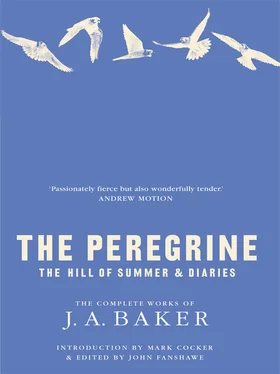Black-headed gull
White gulls are the most conspicuous of all winter birds. Against dark ploughland they are visible even to the feeble human eye when half a mile away. That is why the peregrine kills so many adult gulls, and so few juveniles. Gulls can rise quickly to evade the stoop, but they are easily driven to panic by attack from below. Their whiteness blends with the sky. It may make them invisible to the fish they live on when at sea. Relying on camouflage, perhaps they are slow to adapt themselves to unexpected danger from beneath. It was once believed that peregrines detested gull-flesh. Many gulls are killed by Finnish peregrines during the summer, and gulls are frequently taken on the coast of Norway, and in Scotland.
Lapwing
They are well hidden when feeding in a field, but the flocks always fly up when a peregrine goes over. As soon as they rise, their black and white tails are a target to the falcon’s eye. Their spring display flight makes them careless of danger and less alert to predators. They have the reputation of being hard to kill, but the peregrines I have seen have outflown them fairly easily.
Wigeon
Peregrines prefer wigeon to any other species of duck. It is the commonest coastal duck, in winter, and its broad white wing-markings and loud whistling calls make it very conspicuous. Like all duck, it flies fast and straight, but it cannot dodge easily from the stoop. In March the paired birds are slow to react to the peregrine’s approach. When wildfowling finishes in February, the peregrine kills more duck and is often seen hunting on the coast at nightfall.
To summarise, these are the characteristics that make birds vulnerable to peregrine attack: white or light-coloured plumage or markings, too great a reliance on cryptic colouring, loud repetitive calling, audible wing-beats, straight inflexible flight, prolonged and high song-flight (e.g. skylark and redshank), display and fighting by males in spring, feeding too far from adequate refuge, the habitual use of the same feeding and bathing places, flying to and from roost along known ways, the failure of a flock to bunch together when attacked.
The quantity of food eaten by wild peregrines is difficult to estimate accurately. Captive peregrines are given four to five ounces of beef daily (or its equivalent). Wild juveniles probably eat more than this. A wild tiercel will kill and eat two lapwings each day, or two black-headed gulls, or one woodpigeon. A falcon may eat two woodpigeons – though not wholly – or one larger bird, such as a mallard or a curlew.
During March, a greater variety of prey is taken, including a wider range of bird species and a surprisingly large number of mammals. Moult is beginning, and the time for migration is near. An increased blood supply is needed for the growth of new feathers. The peregrine seems to be always eating. Two birds are killed daily, as well as mice, worms, and insects.
The eyes of a falcon peregrine weigh approximately one ounce each; they are larger and heavier than human eyes. If our eyes were in the same proportion to our bodies as the peregrine’s are to his, a twelve-stone man would have eyes three inches across, weighing four pounds. The whole retina of a hawk’s eye records a resolution of distant objects that is twice as acute as that of the human retina. Where the lateral and binocular visions focus, there are deep-pitted foveal areas; their numerous cells record a resolution eight times as great as ours. This means that a hawk, endlessly scanning the landscape with small abrupt turns of his head, will pick up any point of movement; by focusing upon it he can immediately make it flare up into larger, clearer view.
The peregrine’s view of the land is like the yachtsman’s view of the shore as he sails into the long estuaries. A wake of water recedes behind him, the wake of the pierced horizon glides back on either side. Like the seafarer, the peregrine lives in a pouring-away world of no attachment, a world of wakes and tilting, of sinking planes of land and water. We who are anchored and earthbound cannot envisage this freedom of the eye. The peregrine sees and remembers patterns we do not know exist: the neat squares of orchard and woodland, the endlessly varying quadrilateral shapes of fields. He finds his way across the land by a succession of remembered symmetries. But what does he understand? Does he really ‘know’ that an object that increases in size is moving towards him? Or is it that he believes in the size he sees, so that a distant man is too small to be frightening but a man near is a man huge and therefore terrifying? He may live in a world of endless pulsations, of objects forever contracting or dilating in size. Aimed at a distant bird, a flutter of white wings, he may feel – as it spreads out beneath him like a stain of white – that he can never fail to strike. Everything he is has been evolved to link the targeting eye to the striking talon.
Конец ознакомительного фрагмента.
Текст предоставлен ООО «ЛитРес».
Прочитайте эту книгу целиком, купив полную легальную версию на ЛитРес.
Безопасно оплатить книгу можно банковской картой Visa, MasterCard, Maestro, со счета мобильного телефона, с платежного терминала, в салоне МТС или Связной, через PayPal, WebMoney, Яндекс.Деньги, QIWI Кошелек, бонусными картами или другим удобным Вам способом.












